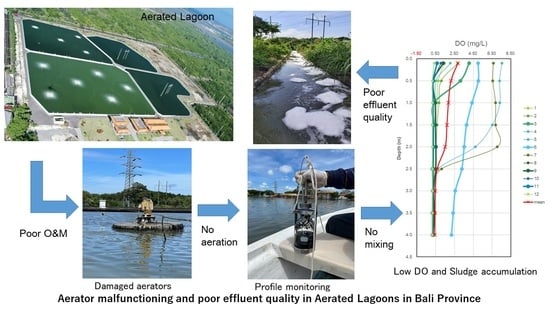Assessment of Water Reclamation and Reuse Potential in Bali Province, Indonesia
Abstract
1. Introduction
2. Materials and Methods
2.1. Water Sources in Bali Province
2.2. Study Areas
2.3. Data Collection
2.3.1. Sampling and Wastewater Quality Analysis
2.3.2. Lagoon Profile Monitoring
2.3.3. Monthly Inflow and Water Quality Data
2.3.4. Rainfall Data
2.3.5. Acceptance and Potential Uses of Reclaimed Water
2.4. Data Analysis
2.4.1. Statistical Analysis
2.4.2. Tourism Water Demand
2.4.3. Oxygen Demand in Aerated Lagoons
3. Results
3.1. Wastewater Quality
3.2. Performance of the WWTPs
3.2.1. Comparison of BOD, COD, and TSS Removal Rates
3.2.2. Performance Evaluation of Suwung WWTP Treatment Process
3.2.3. Profile Monitoring Results
3.3. Wastewater Inflow and Rainfall
3.4. Reclaimed Water Demand and Rainfall
3.5. Acceptance and Potential Uses of Reclaimed Water
4. Discussion
4.1. Potential of Water Reuse in Bali Province
4.2. Improvement in WWTP Treatment Efficiency
5. Conclusions
Author Contributions
Funding
Data Availability Statement
Acknowledgments
Conflicts of Interest
Appendix A
| No. | Regency/City | Area (km2) | Total Population (thousand) |
|---|---|---|---|
| 1 | Badung Regency | 398.8 | 549.5 |
| 2 | Bangli Regency | 526.8 | 267.1 |
| 3 | Buleleng Regency | 1322.7 | 825.1 |
| 4 | Gianyar Regency | 364.4 | 524.0 |
| 5 | Jembrana Regency | 849.1 | 327.9 |
| 6 | Karangasem Regency | 839.3 | 511.3 |
| 7 | Klungkung Regency | 314.0 | 214.0 |
| 8 | Tabanan Regency | 849.3 | 469.3 |
| 9 | Denpasar City | 125.9 | 726.8 |
| No. | Hotel | Category | Interested/Not Interested in Using Reclaimed Water | Reasons |
|---|---|---|---|---|
| 1 | A | Three-star hotel | Interested | The total garden area is 500 m2 |
| 2 | B | Three-star hotel | Interested | They want to be an eco-friendly hotel (the total garden is only 10–15 m2) |
| 3 | C | Four-star hotel | Not Interested | Unpleasant odors and disgust at human waste |
| 4 | D | Four-star hotel | Not Interested | Pathogenic microorganisms |
| 5 | E | Zero-star hotel | Not Interested | Religious or ethical reasons |
| 6 | F | Zero-star hotel | Not Interested | Unpleasant odors |
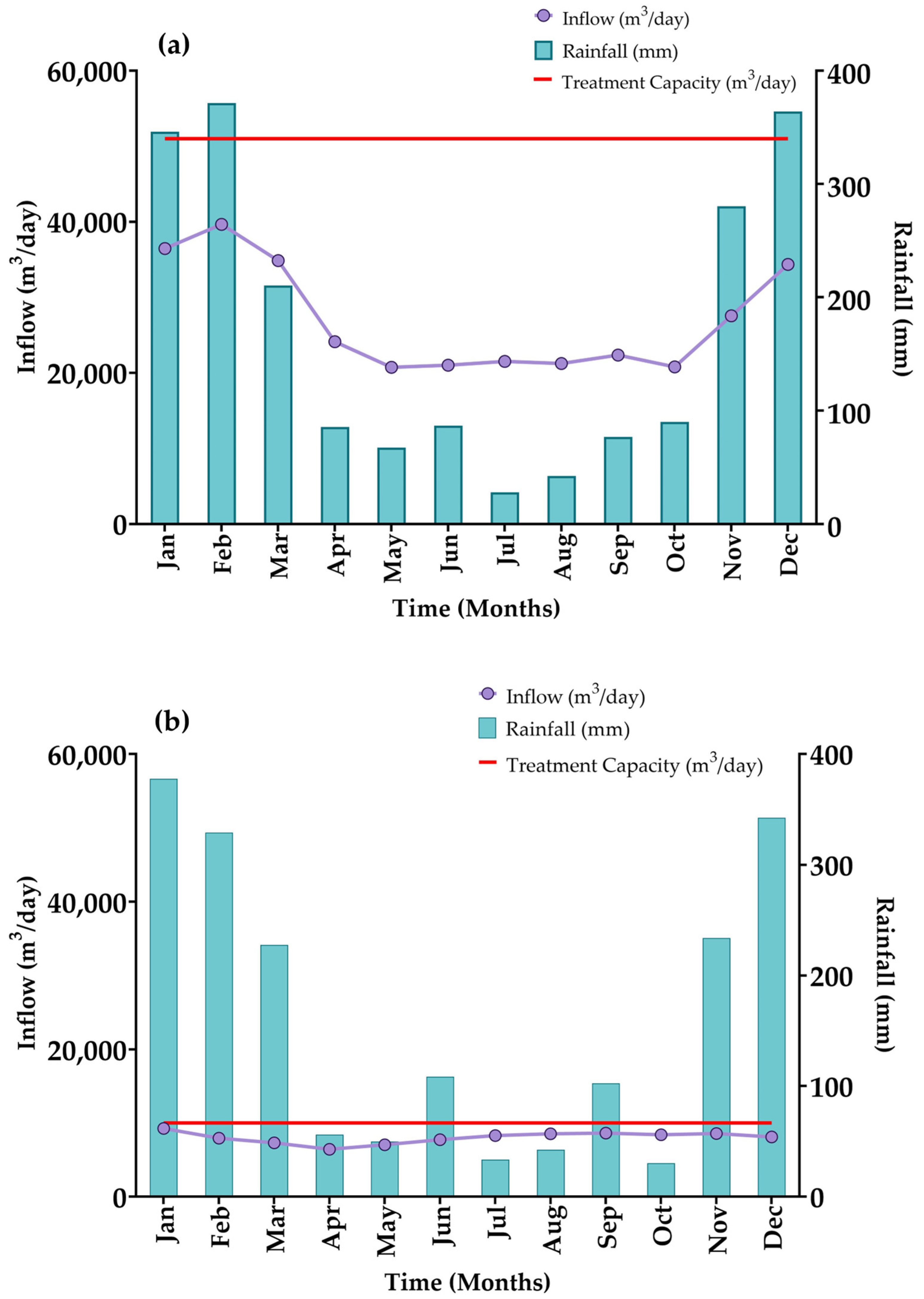
References
- Tortajada, C. Contributions of recycled wastewater to clean water and sanitation Sustainable Development Goals. NPJ Clean Water 2020, 3, 22. [Google Scholar] [CrossRef]
- Gleick, P.H.; Cooley, H. Freshwater scarcity. Annu. Rev. Environ. Resour. 2021, 46, 319–348. [Google Scholar] [CrossRef]
- Gude, V.G. Desalination and water reuse to address global water scarcity. Rev. Environ. Sci. Bio. Technol. 2017, 16, 591–609. [Google Scholar] [CrossRef]
- Flörke, M.; Schneider, C.; McDonald, R.I. Water competition between cities and agriculture driven by climate change and urban growth. Nat. Sustain. 2018, 1, 51–58. [Google Scholar] [CrossRef]
- He, C.; Liu, Z.; Wu, J.; Pan, X.; Fang, Z.; Li, J.; Bryan, B.A. Future global urban water scarcity and potential solutions. Nat. Commun. 2021, 12, 4667. [Google Scholar] [CrossRef] [PubMed]
- UN-Water; UNESCO. The United Nations World Water Development Report 2023: Partnerships and Cooperation for Water. 2023. Available online: https://unesdoc.unesco.org/ark:/48223/pf0000384655 (accessed on 10 July 2023).
- Dalezios, N.R.; Angelakis, A.N.; Eslamian, S. Water scarcity management: Part 1: Methodological framework. Int. J. Glob. Environ. Issues 2018, 17, 1–40. [Google Scholar] [CrossRef]
- Khanal, G.; Thapa, A.; Devkota, N.; Paudel, U.R. A Review on harvesting and harnessing rainwater: An alternative strategy to cope with drinking water scarcity. Water Supply 2020, 20, 2951–2963. [Google Scholar] [CrossRef]
- Tzanakakis, V.A.; Paranychianakis, N.V.; Angelakis, A.N. Water supply and water scarcity. Water 2020, 12, 2347. [Google Scholar] [CrossRef]
- Voulvoulis, N. Water reuse from a circular economy perspective and potential risks from an unregulated approach. Curr. Opin. Environ. Sci. Health 2018, 2, 32–45. [Google Scholar] [CrossRef]
- Drechsel, P.; Qadir, M.; Baumann, J. Water reuse to free up freshwater for higher-value use and increase climate resilience and water productivity. Irrig. Drain. 2022, 71, 100–109. [Google Scholar] [CrossRef]
- Scanlon, B.R.; Fakhreddine, S.; Rateb, A.; de Graaf, I.; Famiglietti, J.; Gleeson, T.; Grafton, R.Q.; Jobbagy, E.; Kebede, S.; Kolusu, S.R.; et al. Global water resources and the role of groundwater in a resilient water future. Nat. Rev. Earth Environ. 2023, 4, 87–101. [Google Scholar] [CrossRef]
- Devaisy, S.; Kandasamy, J.; Nguyen, T.V.; Ratnaweera, H.; Vigneswaran, S. Membranes in Water Reclamation: Treatment, Reuse and Concentrate Management. Membranes 2023, 13, 605. [Google Scholar] [CrossRef]
- Yi, L.; Jiao, W.; Chen, X.; Chen, W. An overview of reclaimed water reuse in China. J. Environ. Sci. 2011, 23, 1585–1593. [Google Scholar] [CrossRef]
- Akpan, V.E.; Omole, D.O.; Bassey, D.E. Assessing the public perceptions of treated wastewater reuse: Opportunities and implications for urban communities in developing countries. Heliyon 2020, 6, e05246. [Google Scholar] [CrossRef]
- Lazarova, V.; Sturny, V.; Sang, G.T. Relevance and benefits of urban water reuse in tourist areas. Water 2012, 4, 107–122. [Google Scholar] [CrossRef]
- Asano, T.; Burton, F.; Leverenz, H. Water Reuse: Issues, Technologies, and Applications; McGraw-Hill Education: New York, NY, USA, 2007. [Google Scholar]
- National Research Council. Water Reuse: Potential for Expanding the Nation’s Water Supply through Reuse of Municipal Wastewater; National Academies Press: Washington, DC, USA, 2012. [Google Scholar]
- Rodriguez, D.J.; Serrano, H.A.; Delgado, A.; Nolasco, D.; Saltiel, G. From Waste to Resource: Shifting Paradigms for Smarter Wastewater Interventions in Latin America and the Caribbean; World Bank: Washington, DC, USA, 2020. [Google Scholar] [CrossRef]
- Takeuchi, H.; Tanaka, H. Water reuse and recycling in Japan—History, current situation, and future perspectives. Water Cycle 2020, 1, 1–12. [Google Scholar] [CrossRef]
- Ait-Mouheb, N.; Mayaux, P.L.; Mateo-Sagasta, J.; Hartani, T.; Molle, B. Water reuse: A resource for Mediterranean agriculture. In Water Resources in the Mediterranean Region; Elsevier: Amsterdam, The Netherlands, 2020; pp. 107–136. [Google Scholar] [CrossRef]
- Kog, Y.C. Water reclamation and reuse in Singapore. J. Environ. Eng. 2020, 146, 03120001. [Google Scholar] [CrossRef]
- Olivieri, A.W.; Pecson, B.; Crook, J.; Hultquist, R. California water reuse—Past, present and future perspectives. In Advances in Chemical Pollution, Environmental Management and Protection; Elsevier: Amsterdam, The Netherlands, 2020; Volume 5, pp. 65–111. [Google Scholar] [CrossRef]
- Shoushtarian, F.; Negahban-Azar, M. Worldwide regulations and guidelines for agricultural water reuse: A critical review. Water 2020, 12, 971. [Google Scholar] [CrossRef]
- Hardy, D.; Cubillo, F.; Han, M.; Li, H. Alternative Water Resources: A Review of Concepts, Solutions, and Experiences; International Water Association (IWA), Alternative Water Resources Cluster: London, UK, 2015; Available online: https://www.pseau.org/outils/ouvrages/iwa_alternative_water_resources_a_reveix_of_concepts_solutions_and_experiences_2015.pdf (accessed on 16 April 2023).
- Statistics of Bali Province. Bali Province in Figures. 2021. Available online: https://bali.bps.go.id/publication/2021/02/26/4ae96914ff22e9b79d8d6551/provinsi-bali-dalam-angka-2021.html (accessed on 26 February 2023).
- Statistics of Bali Province. Bali Province in Figures. 2023. Available online: https://bali.bps.go.id/publication/2023/02/28/b467b61cc7b43c86916a11db/provinsi-bali-dalam-angka-2023.html (accessed on 30 May 2023).
- Statistics of Bali Province. Tourism Statistic in Bali Province. 2020. Available online: https://bali.bps.go.id/publication/2021/07/28/b4daa6a3245079c50f68f6c7/statistik-wisatawan-mancanegara-ke-bali-2020.html (accessed on 26 February 2023).
- Pan, S.Y.; Gao, M.; Kim, H.; Shah, K.J.; Pei, S.L.; Chiang, P.C. Advances and challenges in sustainable tourism toward a green economy. Sci. Total Environ. 2018, 635, 452–469. [Google Scholar] [CrossRef]
- Gössling, S.; Peeters, P.; Hall, C.M.; Ceron, J.P.; Dubois, G.; Scott, D. Tourism and water use: Supply, demand, and security. An International Review. Tour. Manag. 2012, 33, 1–15. [Google Scholar] [CrossRef]
- Okello, C.; Tomasello, B.; Greggio, N.; Wambiji, N.; Antonellini, M. Impact of population growth and climate change on the freshwater resources of Lamu Island, Kenya. Water 2015, 7, 1264–1290. [Google Scholar] [CrossRef]
- Wayan Budiasa, I.; Gusti Ngurah Santosa, I.; Nyoman Sunarta, I.; Ketut Suada, I.; Nyoman Rai, I.; Ratna Dewi, A.A.I.; Dias, V.; Moyzhes, S.; Shchegolkova, N. The potential use of bali wastewater for crop production based on Moscow region experience. Water Resour. 2018, 45, 138–147. [Google Scholar] [CrossRef]
- Ministry of Public Works and Housing of Republic of Indonesia. Performance Book of Water Supply Companies. 2021. Available online: https://drive.google.com/drive/folders/1vp3PoEjtNqVWYYqVmbs2RLW9TUSEaKJ2 (accessed on 26 February 2023).
- Ministry of National Development Planning of the Republic of Indonesia. Profile of the Province’s Drinking Water. 2020. Available online: https://www.nawasis.org/portal/database/airminum/provinsi/51 (accessed on 26 February 2023).
- Statistics of Bali Province. Bali’s Water Statistics. 2015. Available online: https://bali.bps.go.id/publication/2016/10/28/06614ce0d0d60b8576bbec3c/statistik-air-bersih-provinsi-bali-2015.html (accessed on 26 February 2023).
- Dong, Y.; Xing, L.; Zhang, X.; Cao, Q.; Lan, X. Assessment methods of groundwater overdraft area and its application. IOP Conf. Ser. Earth Environ. Sci. 2018, 153, 052005. [Google Scholar] [CrossRef]
- Elshall, A.S.; Arik, A.D.; El-Kadi, A.I.; Pierce, S.; Ye, M.; Burnett, K.M.; Wada, C.A.; Bremer, L.L.; Chun, G. Groundwater sustainability: A review of the interactions between science and policy. Environ. Res. Lett. 2020, 15, 093004. [Google Scholar] [CrossRef]
- JICA. The Comprehensive Study on Water Resources Development and Management in Bali Province in the Republic of Indonesia. 2006. Available online: https://libopac.jica.go.jp/ (accessed on 28 May 2023).
- Eva, M.S. Impact of Rapid Development Growth on Water Resources Situation in Tourism Dependent Economy: A Case Study of Bali, Indonesia. Ph.D. Thesis, Kyoto University, Kyoto, Japan, 26 March 2018. [Google Scholar] [CrossRef]
- Bali’s Environmental Status Report. 2015; Bali Province. Available online: https://docplayer.info/67927994-Laporan-status-lingkungan-hidup-daerah-provinsi-bali-tahun-2015.html (accessed on 5 March 2023).
- Haribowo, R.; Prayogo, T.B.; Vichotama, R. Analysis of water quality of Tukad Badung River, Denpasar, Bali using QUAL2Kw program. J. Technol. Eng. Water Resour. 2021, 1, 40–51. [Google Scholar] [CrossRef]
- Ministry of Environment and Forestry of the Republic of Indonesia. Information on National Water Carrying Capacity and Water Holding Capacity. 2019. Available online: https://www.menlhk.go.id/uploads/site/download/1609210499.pdf (accessed on 5 March 2023).
- As-syakur, A.R.; Tanaka, T.; Osawa, T.; Mahendra, M.S. Indonesian rainfall variability observation using TRMM Multi-Satellite data. Int. J. Remote Sens. 2013, 34, 7723–7738. [Google Scholar] [CrossRef]
- Statistics Indonesia. Indonesia in Figures. Available online: https://www.bps.go.id/publication (accessed on 25 May 2023).
- Sunarta, I.N.; As-Syakur, A.R. Study on the development of water crisis in Bali Island in 2009 and 2013. E-J. Tour. 2015, 2, 33–42. [Google Scholar] [CrossRef]
- Suharta, I.K.; Merit, N.; Sunarta, N. Rainwater infiltration study in Denpasar City. Ecotrophic 2008, 3, 385912. [Google Scholar]
- Rarasari, D.M.G.; Restu, I.W.; Ernawati, N.M. The efficiency of Suwung Wasterwater Treatment Plant (WWTP) in Denpasar City, Bali. J. Mar. Aquat. Sci. 2019, 5, 153–163. [Google Scholar] [CrossRef]
- JICA. The Preparatory Survey on Application of Wastewater Reclaiming in Southern Bali Water Supply System in the Republic of Indonesia. 2012. Available online: https://openjicareport.jica.go.jp/pdf/12080107.pdf (accessed on 17 March 2023).
- Yamamoto, E.M.S.; Sayama, T.; Takara, K. Impact of Rapid Tourism Growth on Water Scarcity in Bali, Indonesia. Indonesian J. Limnol. 2021, 2, 1–16. [Google Scholar] [CrossRef]
- Von Sperling, M. Waste Stabilisation Ponds; IWA Publishing: London, UK, 2007. [Google Scholar]
- Kalbusch, A.; Henning, E.; Brikalski, M.P.; de Luca, F.V.; Konrath, A.C. Impact of coronavirus (COVID-19) spread-prevention actions on urban water consumption. Resour. Conserv. Recycl. 2020, 163, 105098. [Google Scholar] [CrossRef]
- Yazdian, H.; Jamshidi, S. Performance evaluation of wastewater treatment plants under the sewage variations imposed by COVID-19 spread prevention actions. J. Environ. Health Sci. Eng. 2021, 19, 1613–1621. [Google Scholar] [CrossRef]
- Muigai, P.G.; Shiundu, P.M.; Mwaura, F.B.; Kamau, G.N. Correlation between dissolved oxygen and total dissolved solids and their role in the eutrophication of Nairobi dam, Kenya. Int. J. Bio. Chem. Phys. 2010, 18, 38–46. Available online: https://www.academia.edu/download/31478151/The_FT-IR_and_Malarial_Biological_Studie.pdf#page=43 (accessed on 18 April 2023).
- Park, M.; Snyder, S.A. Attenuation of contaminants of emerging concerns by nanofiltration membrane: Rejection mechanism and application in water reuse. In Contaminants of Emerging Concern in Water and Wastewater; Butterworth-Heinemann: Oxford, UK, 2020; pp. 177–206. [Google Scholar] [CrossRef]
- Peng, J.; Kumar, K.; Gross, M.; Kunetz, T.; Wen, Z. Removal of total dissolved solids from wastewater using a revolving algal biofilm reactor. Water Environ. Res. 2020, 92, 766–778. [Google Scholar] [CrossRef]
- Metcalf & Eddy; Abu-Orf, M.; Bowden, G.; Burton, F.L.; Pfrang, W.; Stensel, H.D.; Tchobanoglous, G.; Tsuchihashi, R.; AECOM (Firm). Wastewater Engineering: Treatment and Resource Recovery; McGraw Hill Education: New York, NY, USA, 2014. [Google Scholar]
- WHO. Guidelines for the Safe Use of Wastewater, Excreta, and Greywater. 2006. Available online: https://www.who.int/publications/i/item/9241546824 (accessed on 31 May 2023).
- Oliveira, S.C.; von Sperling, M. Performance evaluation of different wastewater treatment technologies operating in a developing country. J. Water Sanit. Hyg. Dev. 2011, 1, 37–56. [Google Scholar] [CrossRef]
- Mosen, A. Beet-Sugar Handbook; John Wiley & Sons: Hoboken, NJ, USA, 2006. [Google Scholar]
- Iyasele, J.U.; Idiata, D.J. Investigation of the relationship between electrical conductivity and total dissolved solids for mono-valent, di-valent and tri-valent metal compounds. Int. J. Eng. Res. Rev. 2015, 3, 40–48. Available online: https://www.researchgate.net/publication/280325585 (accessed on 2 April 2023).
- Lyu, S.; Chen, W.; Zhang, W.; Fan, Y.; Jiao, W. Wastewater reclamation and reuse in China: Opportunities and challenges. J. Environ. Sci. 2016, 39, 86–96. [Google Scholar] [CrossRef]
- Anderson, J. The environmental benefits of water recycling and reuse. Water Sci. Technol. Water Supply 2003, 3, 1–10. [Google Scholar] [CrossRef]
- Angelakis, A.N.; Durham, B. Water recycling and reuse in EUREAU countries: Trends and challenges. Desalination 2008, 218, 3–12. [Google Scholar] [CrossRef]
- Kumaraswamy, R.; Amha, Y.M.; Anwar, M.Z.; Henschel, A.; Rodriguez, J.; Ahmad, F. Molecular analysis for screening human bacterial pathogens in municipal wastewater treatment and reuse. Environ. Sci. Technol. 2014, 48, 11610–11619. [Google Scholar] [CrossRef] [PubMed]
- Kazner, C.; Wintgens, T.; Dillon, P. (Eds.) Water Reclamation Technologies for Safe Managed Aquifer Recharge; IWA Publishing: London, UK, 2012. [Google Scholar]
- Ablo, A.D.; Etale, A. Beyond technical: Delineating factors influencing recycled water acceptability. Urban Water J. 2022, 1–8. [Google Scholar] [CrossRef]
- Paranychianakis, N.V.; Salgot, M.; Snyder, S.A.; Angelakis, A.N. Water reuse in EU states: Necessity for uniform criteria to mitigate human and environmental risks. Crit. Rev. Environ. Sci. Technol. 2015, 45, 1409–1468. [Google Scholar] [CrossRef]
- Von Sperling, M. Basic Principles of Wastewater Treatment; IWA Publishing: London, UK, 2007. [Google Scholar]

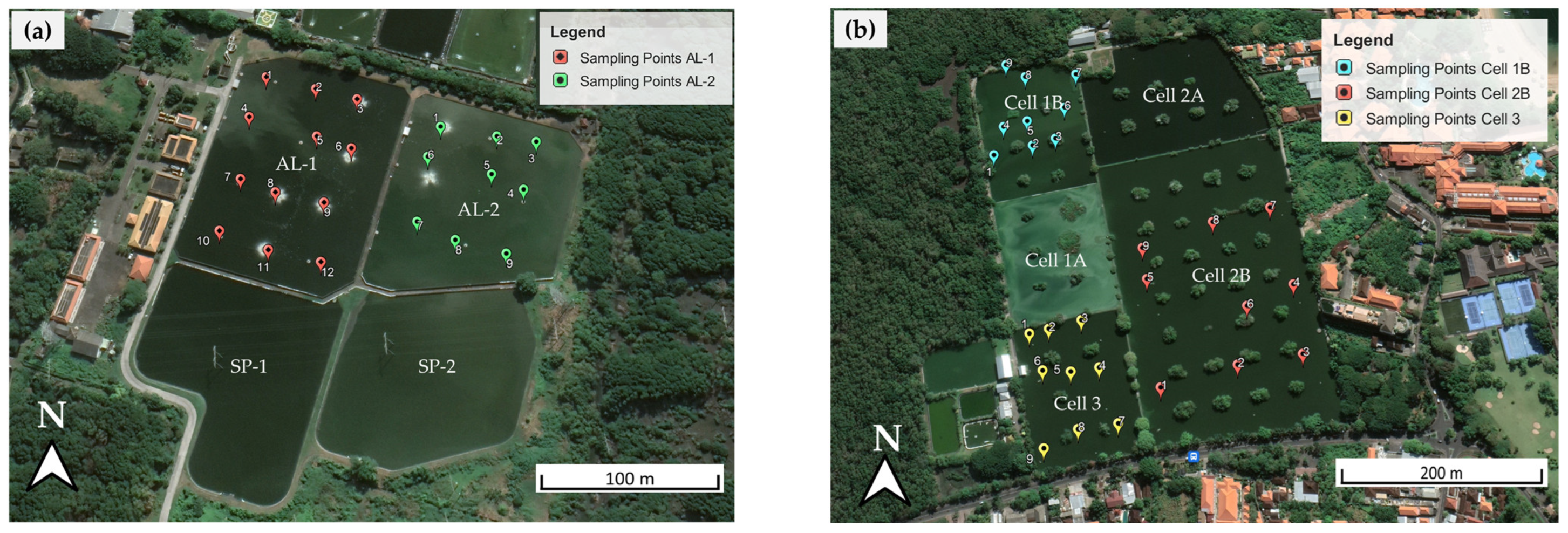


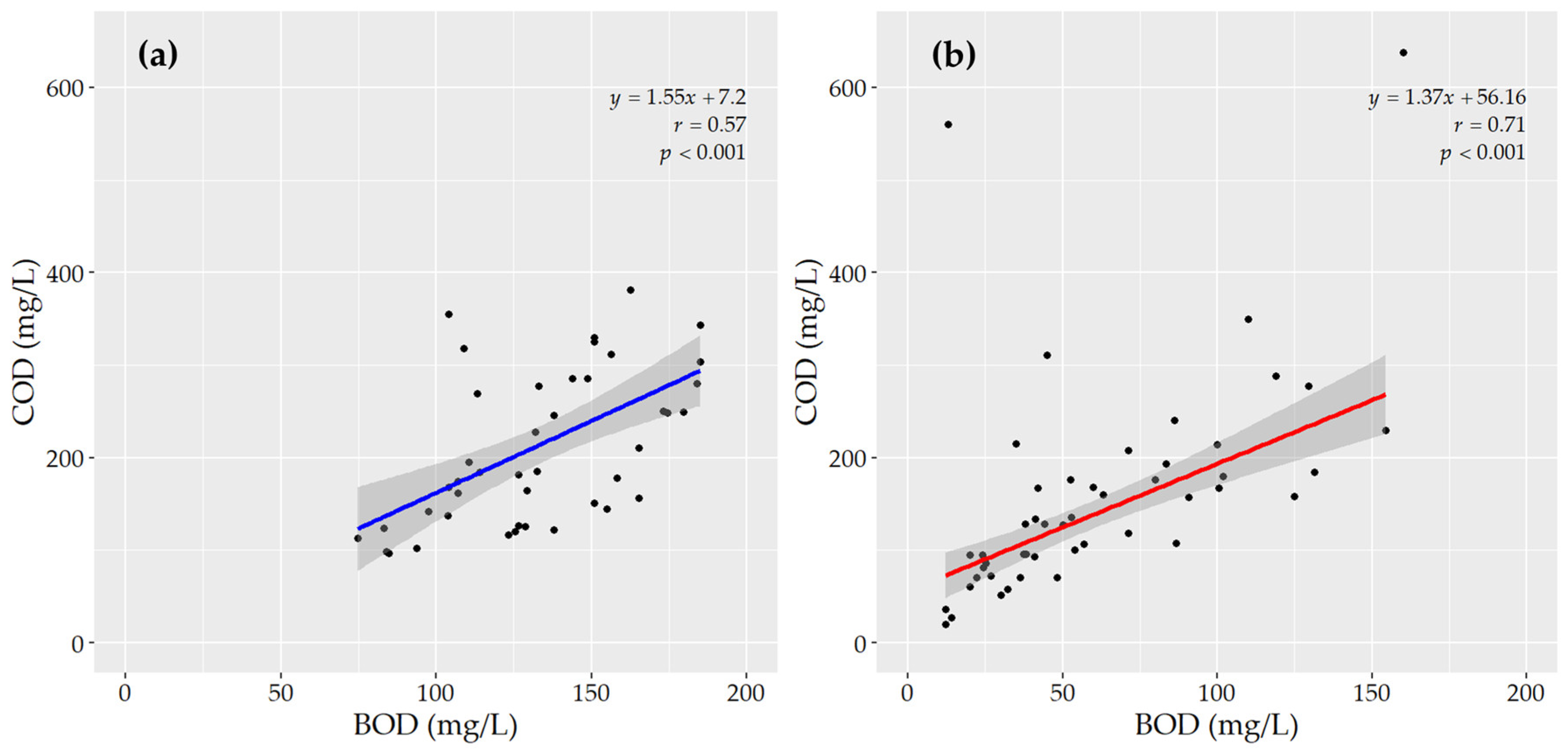


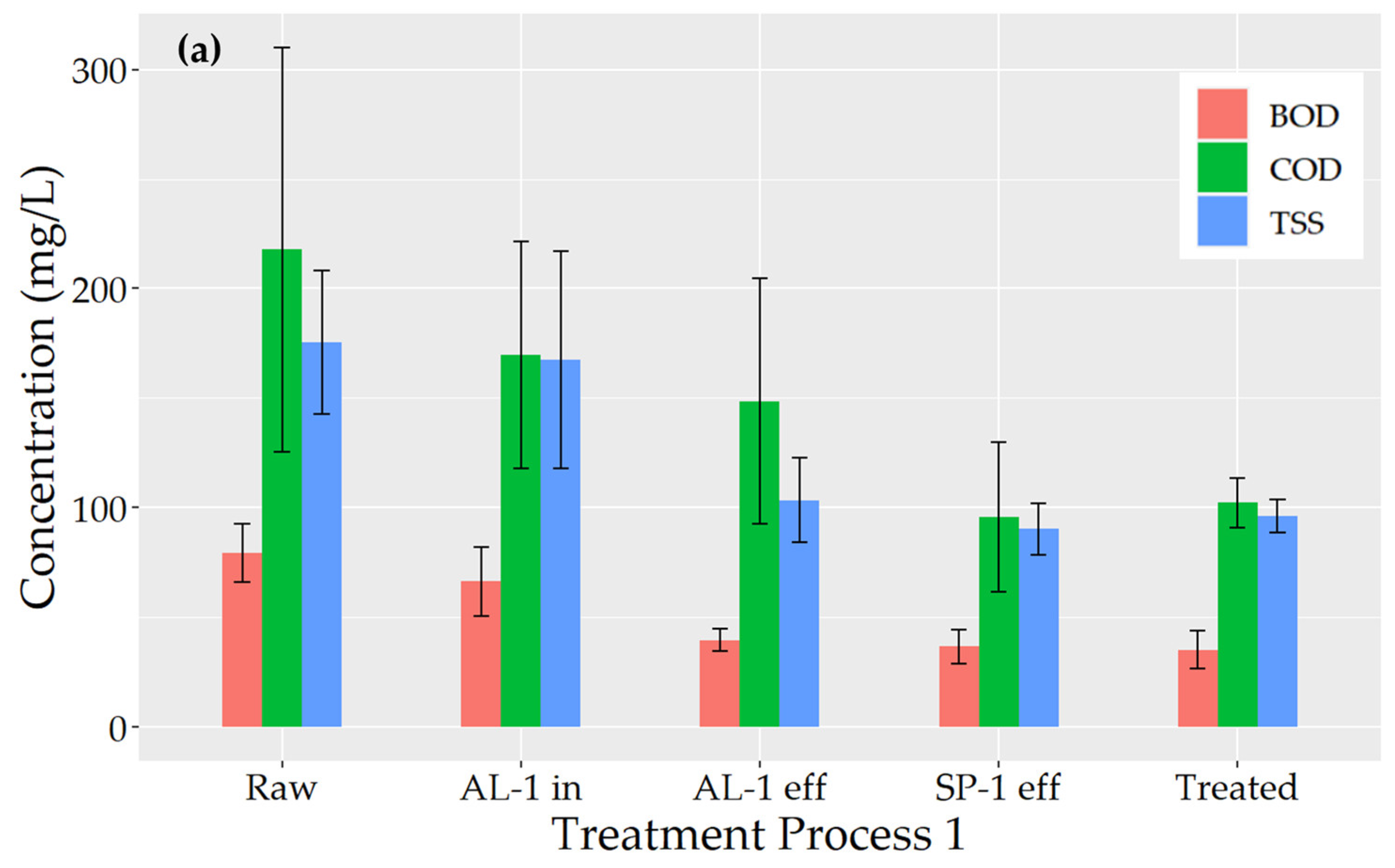
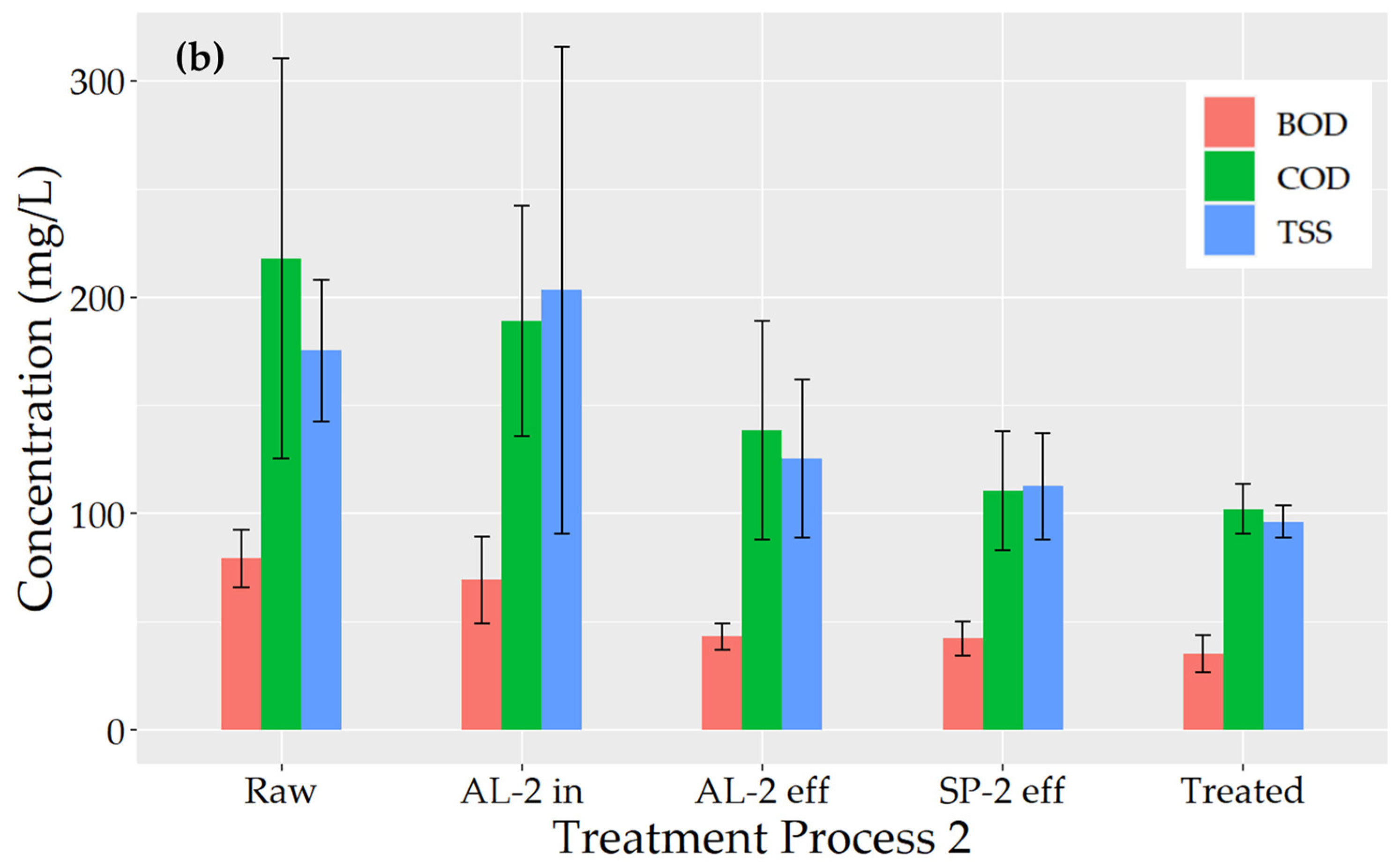

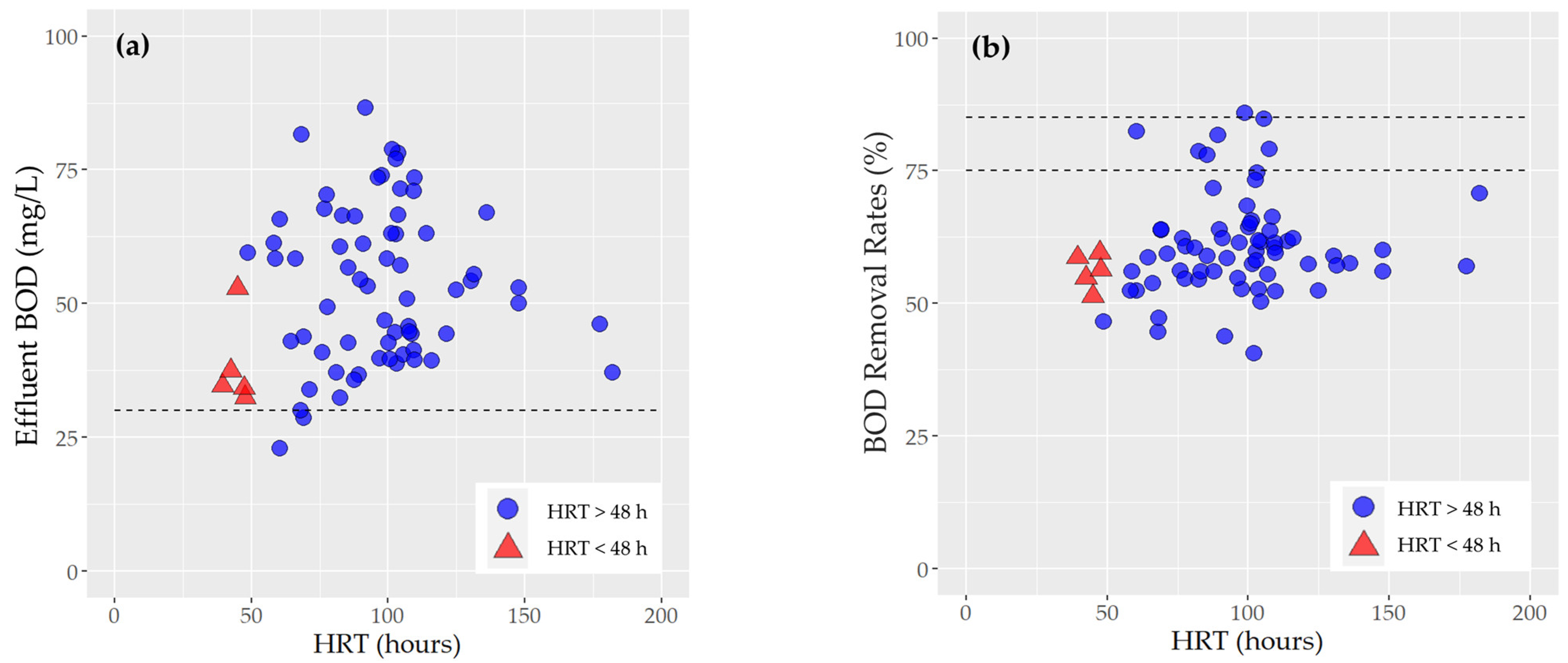


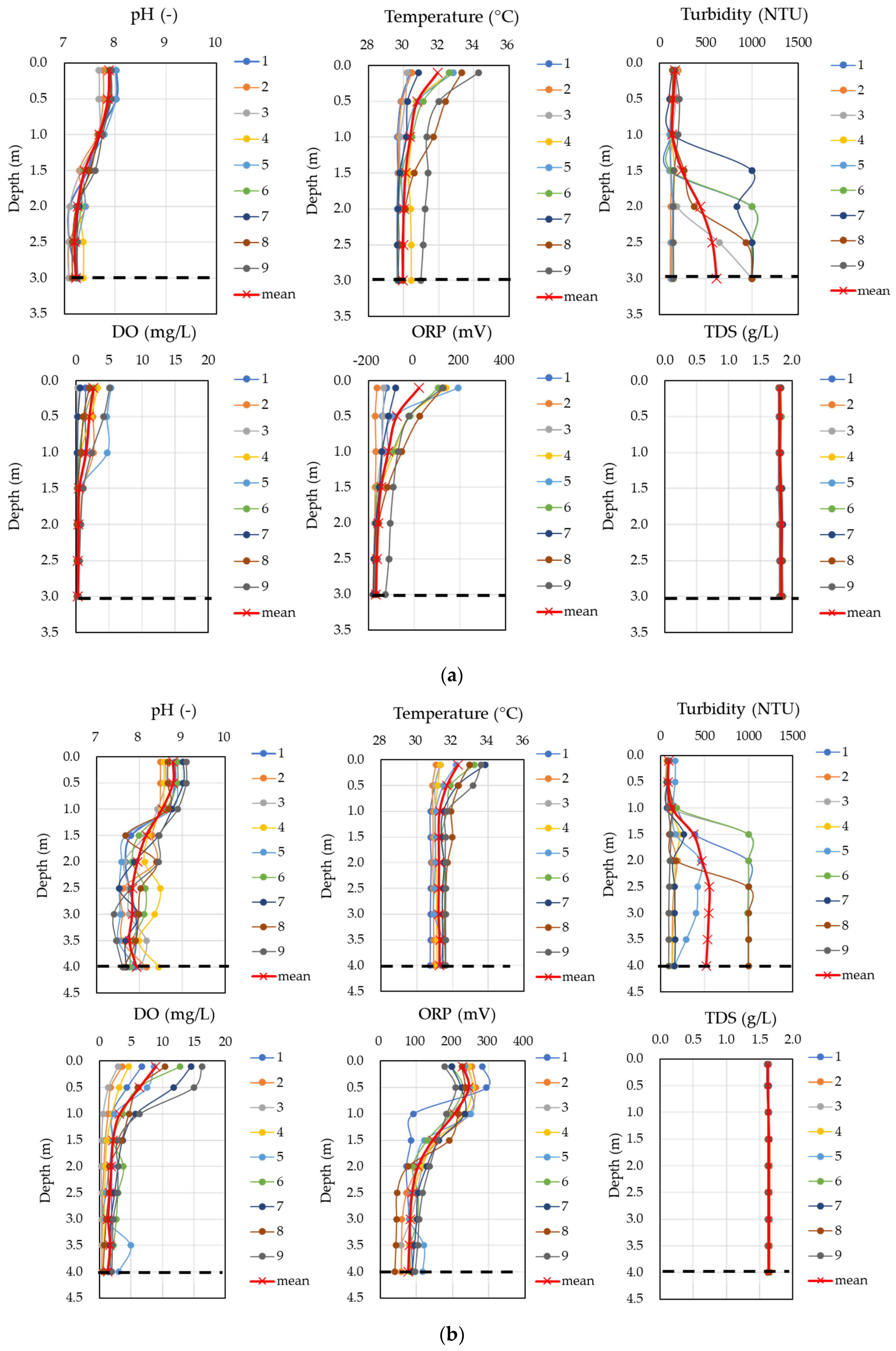
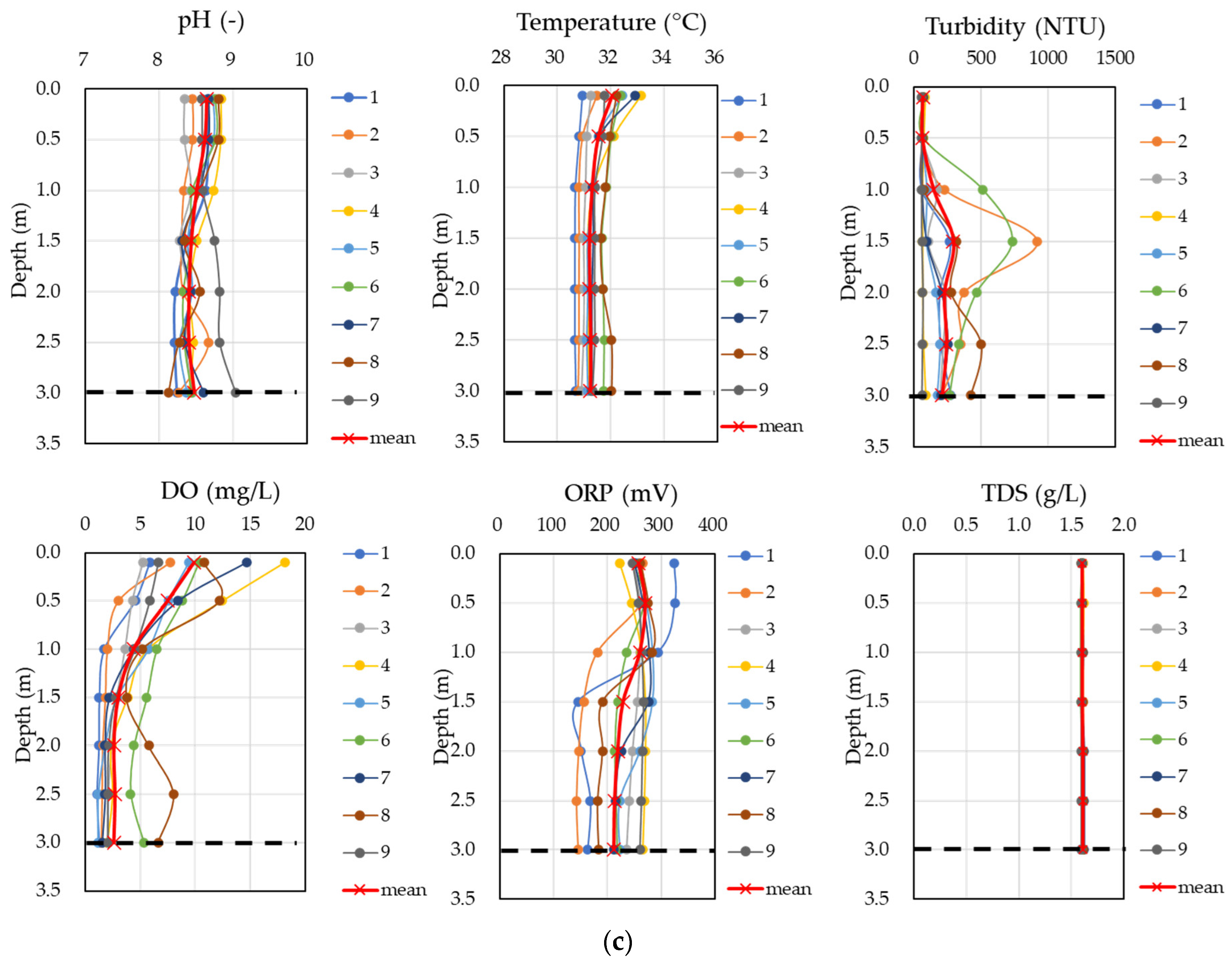


| Parameter | Unit | Analytical Device |
|---|---|---|
| Physicochemical | ||
| Temperature | °C | Horiba Laquatwin EC-33 (Pocket Water Quality Meters); HORIBA Advanced Techno Co., Ltd., Kyoto, Japan |
| Electrical conductivity | μS/cm | |
| TDS | mg/L | |
| TSS | mg/L | DR900 Multiparameter Portable Colorimeter; Hach Company, Loveland, CO, USA |
| pH | - | Horiba Laquatwin pH-22 (Pocket Water Quality Meters); HORIBA Advanced Techno Co., Ltd., Kyoto, Japan |
| BOD | mg/L | Kyoritsu Pack Test BOD (Visual Colorimetric Method); Kyoritsu Chemical-Check Lab., Corp., Yokohama, Japan |
| COD | mg/L | DR900 Multiparameter Portable Colorimeter; Hach Company, Loveland, CO, USA |
| Microbial | ||
| E. coli | CFU/100 mL | Compact Dry Nissui; Nissui Pharmaceutical Co., Ltd., Tokyo, Japan |
| Total coliforms | CFU/100 mL |
Disclaimer/Publisher’s Note: The statements, opinions and data contained in all publications are solely those of the individual author(s) and contributor(s) and not of MDPI and/or the editor(s). MDPI and/or the editor(s) disclaim responsibility for any injury to people or property resulting from any ideas, methods, instructions or products referred to in the content. |
© 2023 by the authors. Licensee MDPI, Basel, Switzerland. This article is an open access article distributed under the terms and conditions of the Creative Commons Attribution (CC BY) license (https://creativecommons.org/licenses/by/4.0/).
Share and Cite
Widianingtias, M.; Kazama, S.; Benyapa, S.; Takizawa, S. Assessment of Water Reclamation and Reuse Potential in Bali Province, Indonesia. Water 2023, 15, 2642. https://doi.org/10.3390/w15142642
Widianingtias M, Kazama S, Benyapa S, Takizawa S. Assessment of Water Reclamation and Reuse Potential in Bali Province, Indonesia. Water. 2023; 15(14):2642. https://doi.org/10.3390/w15142642
Chicago/Turabian StyleWidianingtias, Mitria, Shinobu Kazama, Sawangjang Benyapa, and Satoshi Takizawa. 2023. "Assessment of Water Reclamation and Reuse Potential in Bali Province, Indonesia" Water 15, no. 14: 2642. https://doi.org/10.3390/w15142642
APA StyleWidianingtias, M., Kazama, S., Benyapa, S., & Takizawa, S. (2023). Assessment of Water Reclamation and Reuse Potential in Bali Province, Indonesia. Water, 15(14), 2642. https://doi.org/10.3390/w15142642








